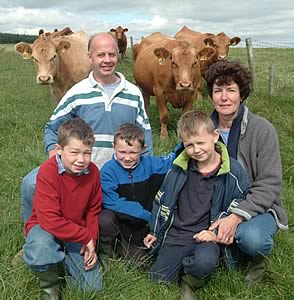| 15/08/06
Suckler cow strategies will come under the microscope later this
month when the Greenshields family open their gate at South Mains,
Sanquhar on 29 August and discuss the benefits of introducing the
Stabiliser to their 180 cow herd.
Douglas and Lorna Greenshsields with John, Robert and Andrew
and some of their purebred Stabiliser cows.
 |
Introducing the Stabiliser as a modern functional suckler
cow to South Mains is beginning to make a significant contribution
to cost savings as well as improving overall output. “Better
health and fertility, reduced calving problems, and lower labour
requirements are among the benefits together with the opportunity
to work with cattle with a quiet temperament,” explains Mr
Greenshields who is currently up grading a commercial suckler herd
to pure Stabiliser status on the 1,700 acre LFA unit which he farms
in partnership with his wife, Lorna and also carries a 2,100 ewe
sheep enterprise.
Five years ago, Douglas and Lorna Greenshields were among the first
producers to introduce the Stabiliser as a damline to Scotland. “We
became aware of the Stabiliser is a composite damline which had
been originally imported from the USA eight years ago where it
was developed to deliver consistent high quality beef produced
for least cost per kilo in subsidy free systems which reflect those
in the UK post CAP reform.
“I investgated further the science that had gone in to developing
the Stabiliser concept, visited the research centre in Nebraska
and I concluded it did stack up. The US scientists had taken a
leaf out of the British pig industry’s books and had selected
certain beef breeds for particular traits, and at the same time
they had maintained hybrid vigour,” he explained. “We
concluded that the Stabiliser offered the solution.”
At the time, the Greenshields had depended on beef bred suckler
cow replacements from the dairy herd. “The Holstein influence
was becoming so strong in these cattle. They were lasting for an
average of six calves by which stage a large percentage were milking
off one or two teats, furthermore the herd was suffering from impaired
fertility and a barren rate of 12%. We also had to contend with
the fact these cattle were being sourced from the bottom 25% of
the dairy herd.”
While the couple have carried out ET work and now have a small
purebred herd of Stabilisers, their main focus is on grading up
their 180 cow commercial herd. Five purebred Stabiliser bulls run
with the herd and so far all the heifers have been retained.
“We’ve found these Stabiliser crosses, the F1s are
reaching sufficnt body weight to calve at two years. Calving problems
are now minimal, and consequently the workload has been reduced,
and new born calves tend to be more lively. The number of barrens
has been halved during the past two years to 6%, and overall fertility
has improved to the extent the calving pattern has tightened enabling
90% of the herd to calve over three cycles.
“Since we closed the herd two years ago, we’ve been
able to take control over health issues and started to notice the
benefits. We’ve had less pneumonia problems, scours have
been eliminated. So far we haven’t had udder problems in
the stabs. We appreciate the Stabiliser’s quiet temperament
and we are confident they will last however we will have to wait
see. My gut feeling is these cattle have got what it takes. Admitedly,
longevity slows down the opportunity for faster genetic progress,
however our target should be for a cow that will match the Luing’s
lifespan of at least 15 years.”
He adds: “Suckler cow producers are under pressure to make
essential cost savings if they are to create a sustainable profitable
system that will embrace the full imapct of the new regime in the
run up to 2012. We are confident that the Stabiliser will make
a significant contribution towards that goal, sufficient to ensure
a future for suckler beef at South Mains which we believe is essential
to complement a thriving sheep enterprise.”
Further details on the South Mains open day can be obtained from
the Stabiliser Cattle Company’s Richard Fuller on 07970 097519.
 Support
for the Northwest Stabiliser Project Support
for the Northwest Stabiliser Project
 Northwest
Stabiliser Project - interest gaining momentum Northwest
Stabiliser Project - interest gaining momentum
 Beef from the Dairy Herd at Dairy Event 2006 Beef from the Dairy Herd at Dairy Event 2006 |


